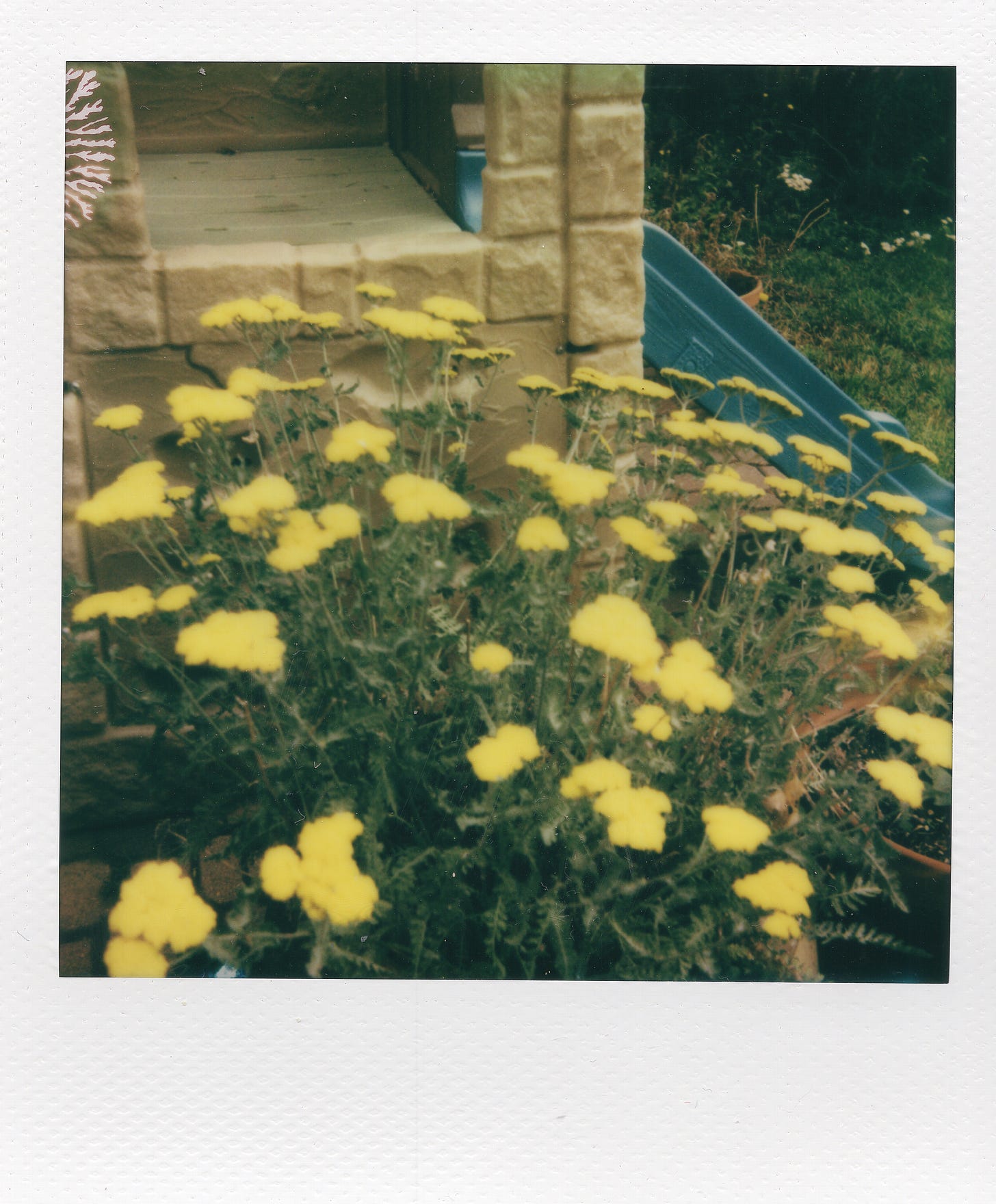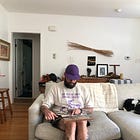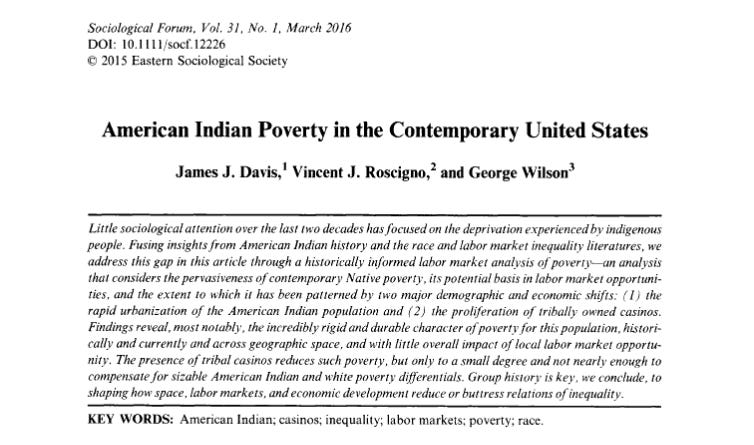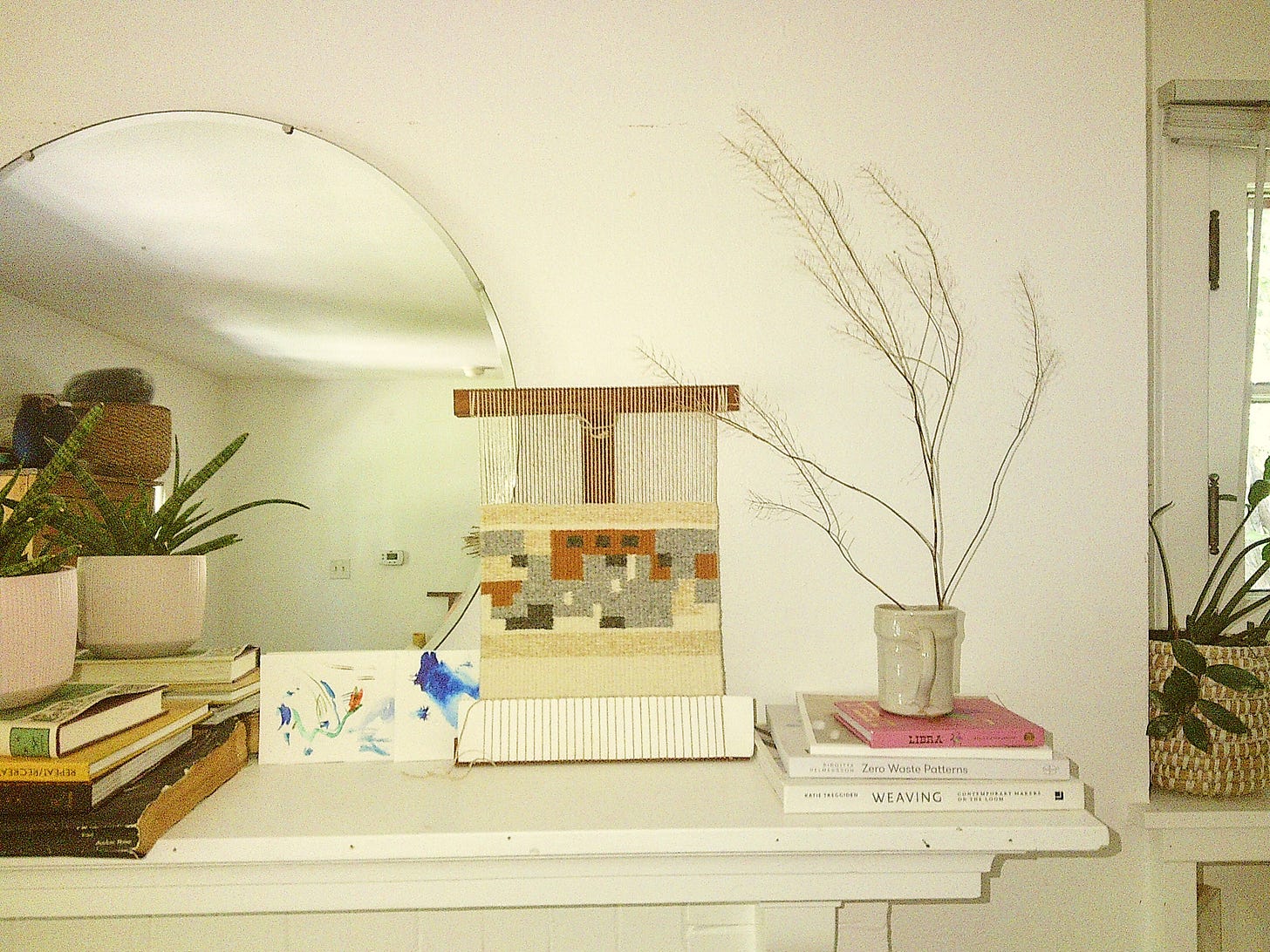This week’s essay has a genourous free preview but is partly paywalled for the paid subscribers. If you are diggin’ what I am throwing down in the free preview, sign up for that paid subscription or ask me to gift you one to read the rest. Regardless, I would love for you to become a free or paid subscriber. All free and paid subscribers are what make this whole project spin round. Paid subscriptions go to paying for web hosting, silly stickers, and materials for my weaving. Both Free and Paid subscribers are literally a jolt in the arm that makes me believe that my writing matters. Every other week, a free essay is available. If you want to read all my essays, a paid subscription gets you access to all the essays published as part of this projects. Thanks for caring enough to read and support. Your attention means the world to me.
Happy summer solstice from my wee yarrow filled garden in the foothills of the rocky mountains to you. I was happy to see my weekly email from one of my teachers Tonja Reichley full of yarrow and a call to invite yarrow into this liminal space as we shift into the darkening side of the year. Reichley wisely encouraged us to witness this liminal moment of pause at the solstice as all of nature seems to stand still in a moment of repose after Bealtaine. As I am still healing from my bicycle crash, I am also in this moment of repose after the busyness of my Bealtaine season. I feel this resonance that I am blooming forth in interesting and novel ways this summer solstice with my yarrow patches—ways I had no idea that I would some months ago. As an elder that I encountered this week on a bike ride to a blood draw wisely noted: “This is life.” Yes, she is right; Change is always the rule, no matter how ossified and intractable things appear or we want them to be.
Ok, we got some folks that want to meet up for fiber community and be a part of Denver’s fiber infrastructure. Woohoo! If you missed my essay last week, I explained how I want to be a part of a in person Fiber ARTS (FARTS) group in central Denver.
My progress this week toward that goal was getting inspired to make a poster. I thought about making it myself, but then realized I needed back up. I think I am going to commission someone to illustrate a logo for the local fiber meet up and start thinking through the logistics of it here in this space. I can already see the bumper sticker and t-shirts coming. LMAO. As for name, how does Weird Wares Web sound as a name? We could say that we are trying to create a whole different World Wide Web. tehehehe dad joke engaged.
I’m a sociologist, so I live on that ever threaded razor’s edge between the perpetuation of the status quo in society and change. Yes, I do believe change is possible and happening all the time. Nothing cemented this more for me than laying my mom to rest. My person was gone and I still live in the wake of that loss. Professionally as a practitioner of civilian oversight of criminal justice processes, I live in that space where we as a society attempt to move institutions toward transparency, justice, and democracy. Before that, my one and only co-authored academic article documented how the soveign American Indian Nations of the United States used their gaming operations to lower the likelihood of poverty for indigenous people living near them. Again and again, I have documented and seen changes happening in the most unlikely places. You know why? Because people don’t give up.
Don’t get me wrong, I love me a methodical critique of the ossified structures of our society, but even those examples show people power. I see the lack of change in our foreign policy, the lack of ways that we support people, and the ways we have failed to repair the harms we have caused. I see the ways that we have eviscerated unions and bailed out banks making junk bets. Yet, even in those instances, all those policy choices came about because of groups of policymakers who were elected to control key government offices and used their positions to poison the well of our social democracy. There is a reason why folx talk about the corrupting influence of money in politics. It’s because people matter. Change, for better or worse, has and always will bubbling up from individual people and groups, who are so far ahead of our institutions and want to put their mark on our society. I just hope that its the masses of workers and those representing those workers that get to be making our policy, not a bunch of people paid off by millionaires and billionaires.
You might ask, well what does this have to do with art? Well, some folks, like theorist Mark Fisher, believe that we are living in a lost future where nothing revolutionary can be made, where artists (people who make art) cannot make that ever decisive break with the current malaise that can cause a great societal rupture. Instead of the new, Fisher argues that all we get are a constant regurgitation of the stories, songs, and movies of the past. He correctly notes how the businesses bankrolling art are tremendously risk averse and would rather put out Fast & the Furious 47 and cash that easy money check than bankroll the BBC cult classic Hypernormalisation. Instead of giving a bag of cash to Daniel Kwan, Daniel Scheinert to make their follow up to Everything Everywhere All At Once, studios act like they are edgy by giving chris nolan 128 million dollars to make memento 16 or some historical drama. Instead of A Love Supreme by Coltrane, we get Taylor Swift’s “The Tortured Poets Department.” I don’t say this to to denigrate anyone who enjoys popular culture. No, far from it.
I say this to underscore Fisher’s main point that there are real forces funneling folks into his conception of a “lost future” where market limits and the stranglehold of the two part system in the United States have made it almost impossible for people to imagine a future outside our hypercapitalist, neoliberal reality. Consequently. what we get is stuff that lulls us into a comfortable sense of nostalgia, rather than jolt us awake to what is possible.
I think textiles is one of those revolutionary practices that has jolted me awake to new possibilities outside our current reality. This current piece I am working on is a great example of that. I am not doing my typical fiber spell work that I have been doing for some years now. Instead, I am just trying to improvise my way through recreating a moment of covered over graffiti that I saw on a bike ride. What’s consequential about that whole project is that it is a realm of culture far away from anyone with any money or any hope of making money off of someone else’s art. No one is making the call on what I make. I make whatever I darn well please that pleases me. This freedom to make as we please on our own terms with what we have available is what has sparked artistic revolutions and helped people realize their own power for centuries.
The whole process of creating this weaving was just to document everyday life in fiber. Even the process of deciding to weave the image was so drenched in humanity. Someone decided to tag the underside of a bridge. Someone decided that the graffiti was unsightly and had their local “improvement district” paint it over. Here then I came seeing this moment of upity censorship and finding beauty in its happenstance nature, its drama. I took a picture and then set out to weave that moment. I went to my local crafts store, bought some already spun and dyed Jamieson and Smith shetland yarn, and set to work translating the image of the painted over graffiti into a textile. This whole set of relationships just underscores how we are all interconnected with each other in our little community, even if we don’t know explicitly who made any of those decisions. I am connected to the graffiti artist, the upity citizen, the improvement district worker, and everyone else that sees the tag. Together, we are all embroiled in life’s greatest piece of art: everyday life.
As Gil Scott-Heron said, “the Revolution will not be televised,” meaning it wont get a 20 minutes special or be “captured on any film.”1 No, it will happen between our two ears and in our relationships to one another, and our collective artmaking. The revolution won’t be hung in a gallery. For me, I am going to hang my piece up for a spell next to the painted over tag that inspired it. You know why? Well, it’s simple. The revolution will happen in everyday life as we live out our values and politics in everyday life. Consequently, I am going to hang the art in its everyday context. Let it be the embodiment of the radical creative revolution that I would love everyone to participate in. Let it be the woven thread that inspires us all to remember that change is always possible and that we can weave ourselves together toward a world where everyone is taken care of and all past harms are repaired.
This is why I believe in people and keep my eyes peeled on them. That’s where the movement is happening. I believe in peoples’ capacity to transform themselves and the world around them, because textiles completely transformed me. Learning a craft and plying it when machines had mostly taken over much of the work gave me the confidence to keep plugging away no matter the odds. Right in this moment there are literally thousands of people changing their mind on American foreign policy and waking up to the simple fact that we should be taking care of our own people not sending bombs to blow up Palestinians. They are in solidarity with Palestine, and that may be the first time they have been in solidarity with someone who doesn’t look like them ever. There are thousands of people fighting for what fisher would consider lost futures. Except, here’s the rub, those futures won’t ever be dead as long as one of us is fighting for it.
That’s what I hang my steely resilience on every night when I decide to keep fighting again tomorrow. I believe that you, me, and all our kin are capable of change and creation. People pay a lot of money trying to convince you that you are powerless and need their readymade solutions to all sorts of problems. Don’t listen to them. Let this sink in deeply: Your art matters. Your small actions of solidarity, reparations, and inclusion matter. Your work to build a life that doesn’t harm others matters. Well, that’s just what this incredibly average white dude raised by a single mom in the rustbelt, surrounded by his autoworker and tool & dye uncles and aunts thinks. Feel free to chunk it into the dustpin if its not your bag, or hold it close like an amulet of protection in a world that wants to beat you down, down, down. Don’t let the world beat you down though. We need you.
Most of this last half was written while repeatedly listening to Thursday’s new song “Application for Release from The Dream.” It’s perfectly captures that feeling of me just wanting you to keep going:
“Have we seen enough?
Holding on to you
Have we seen enough?
Holding on for you
Please never try to see it through
And I'll try to stay too
Please never try to see it through
And I'll try to find”
Thanks for being here, friend. I appreciate you. I hope you have a great week.
Best,
James
Check this short video of Gil Scot Heron explaining what he meant by the song.




